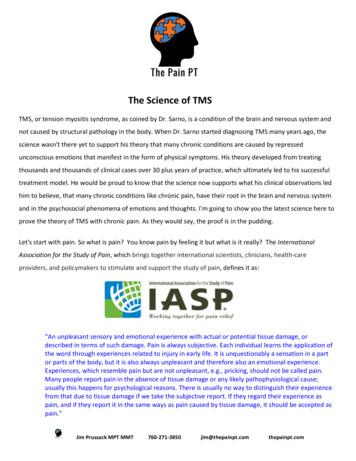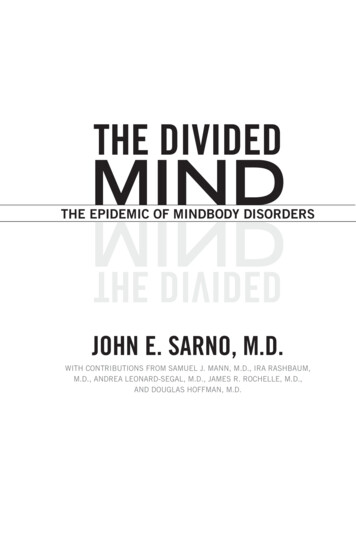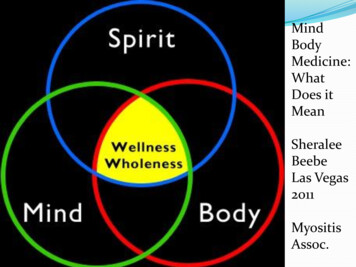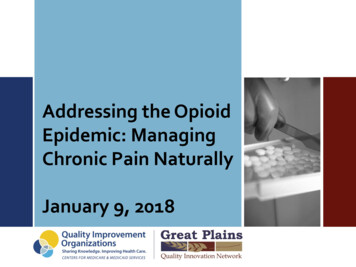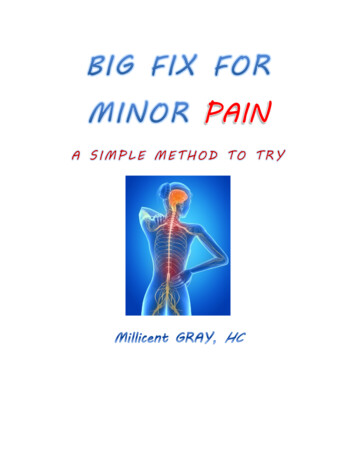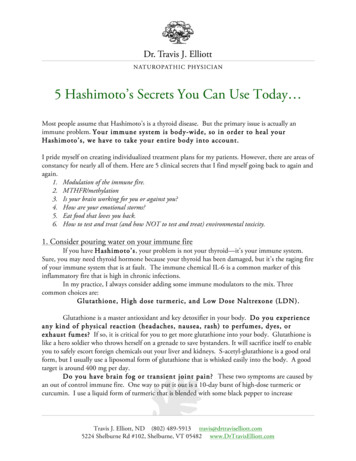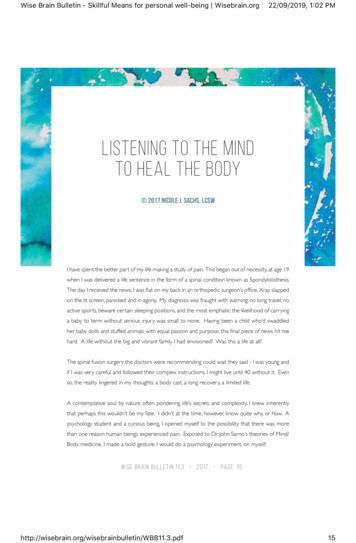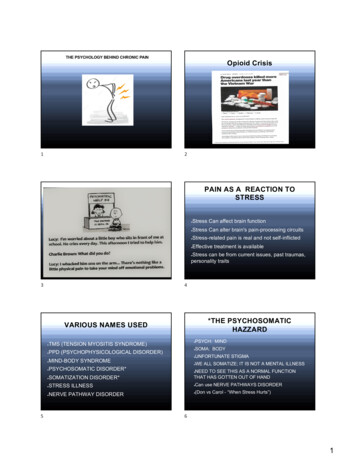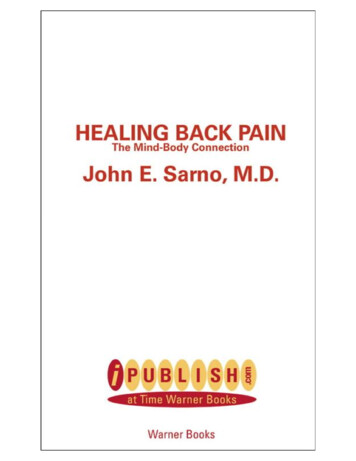
Transcription
WHAT DR. SARNOTELLS HIS TMS PATIENTS:Resume physical activity. It won t hurt you.Talk to your brain: tell it you won t take it anymore.Stop all physical treatments for your back they may beblocking your recovery.DON T:Repress your anger or emotions they can give you a painin the back.Think of yourself as being injured. Psychologicalconditioning contributes to ongoing back pain.Be intimidated by back pain. You have the power toovercome it.HEALING BACK PAINUsing the actual case histories of his own patients, Dr. John Sarnoshows why tension and unexpressed emotions particularlyanger cause chronic back pain, and how awareness andunderstanding are the first steps to doing something about it.
ALSO BY JOHN E. SARNO, M.D.Mind Over Back Pain
HEALINGBACK PAINThe Mind-Body ConnectionJ O H N E . SA R N O , M . D .WARNER BOOKSA Time Warner Company
ØÛßÔ ÒÙ ÞßÝÕ Ðß ÒòÝ § ·¹ w ïççï ¾§ Ö ² Ûò Í¿ ² ô ÓòÜòß ·¹ - »-» ª»¼ò Ò ¿ º ·- ¾ µ ³¿§ ¾» » ¼«½»¼ ·² ¿²§º ³ ¾§ ¿²§ » »½ ²·½ ³»½ ¿²·½¿ ³»¿²-ô ·²½ «¼·²¹ ·²º ³¿ · ²- ¿¹» ¿²¼ » ·»ª¿ -§- »³-ô · « » ³·--· ² ·² · ·²¹ º ³ » «¾ ·- » ô » ½» ¾§ ¿ »ª·» » ³¿§ « » ¾ ·»º ¿--¿¹»- ·² ¿ »ª·» òÚ ·²º ³¿ · ² ¿¼¼ »-- É¿ ²» Þ µ-ô ïîéï ߪ»²«» º »ß³» ·½¿-ô Ò» Ç µô ÒÇ ïððîðòÉ ß Ì·³» É¿ ²» Ý ³ ¿²§ ÍÞÒ ðóéëçëóêïçíóïß ¿¼» ¿ » ¾¿½µ »¼· · ² º ·- ¾ µ ¿- «¾ ·- »¼ ·² ïççï ¾§É¿ ²» Þ µ-òÚ· - »Þ µ »¼· · ²æ Ó¿ ½ îððïÊ·-· « É»¾ -· » ¿ ò·Ð«¾ ·- ò½ ³
ContentsINTRODUCTIONvii11. The Manifestations of TMS2. The Psychology of TMS293. The Physiology of TMS594. The Treatment of TMS705. The Traditional (Conventional) Diagnoses 976. The Traditional (Conventional) Treatments 1207. Mind and BodyAPPENDIX:132Letters from PatientsINDEX185170
IntroductionThis book is the successor to Mind Over Back Pain, which waspublished in 1984. It described a medical disorder known as theTension Myositis Syndrome (TMS), which I have had reason tobelieve is the major cause of the common syndromes of paininvolving the neck, shoulders, back, buttocks and limbs. In the yearssince that first publication I have further developed and clarifiedmy concepts about how to diagnose and treat TMS, hence thenecessity for this book.Over the years the increasing incidence of these pain syndromeshas created a public health problem of impressive proportions. Onecontinues to see the statistic that somewhere around 80 percent ofthe population have a history of one of these painful conditions. Anarticle in Forbes magazine in August 1986 reported that 56 billionare spent annually to deal with the consequences of this ubiquitousmedical disorder. It is the first cause of worker absenteeism in thiscountry and ranks second behind respiratory infections as a reasonfor a doctor visit.All this has happened in the past thirty years. Why? After afew million years of evolution, has the American back suddenlybecome incompetent? Why are so many people prone to backvii
viiiIntroductioninjury? And why has the medical profession proven so helpless tostem the epidemic?It is this book s purpose to answer those and many otherquestions about this widespread problem. The thesis will beadvanced that, like all epidemics, this one is the result of medicine sfailure to recognize the nature of the disease, that is, to make anaccurate diagnosis. The plague ravaged the world because no oneknew anything about bacteriology or epidemiology at the time. Itmay be hard to believe that highly sophisticated twentieth-centurymedicine cannot properly identify the cause of something so simpleand common as these pain disorders but physicians and medicalresearchers are, after all, still human and, therefore, not all-knowingand, most important, subject to the enduring weakness of bias.The pertinent bias here is that these common pain syndromesmust be the result of structural abnormalities of the spine orchemically or mechanically induced deficiencies of muscle. Of equalimportance is another bias held by conventional medicine thatemotions do not induce physiologic change. Experience with TMScontradicts both biases. The disorder is a benign (though painful)physiologic aberration of soft tissue (not the spine), and it is causedby an emotional process.I first appreciated the magnitude of this problem in 1965 whenI joined the staff of what is now known as the Howard A. RuskInstitute of Rehabilitation Medicine at New York University MedicalCenter as director of outpatient services. It was my first introductionto large numbers of patients with neck, shoulder, back and buttockpain. Conventional medical training had taught me that these painswere primarily due to a variety of structural abnormalities of thespine, most commonly arthritic and disc disorders, or to a vaguegroup of muscle conditions attributed to poor posture, underexercise,overexertion and the like. Pain in the legs or arms was presumeddue to compression (pinching) of nerves. However, it was not atall clear how these abnormalities actually produced the pain.The rationale for the treatment prescribed was equally
Introductionixperplexing. Treatment included injections, deep heat in the form ofultrasound, massage and exercise. No one was sure what theseregimens were supposed to do but they seemed to help in somecases. It was said that the exercise strengthened the abdominaland back muscles and that this somehow supported the spine andprevented pain.The experience of treating these patients was frustrating anddepressing; one could never predict the outcome. Further, it wastroubling to realize that the pattern of pain and physical examinationfindings often did not correlate with the presumed reason for thepain. For example, pain might be attributed to degenerative arthriticchanges at the lower end of the spine but the patient might havepain in places that had nothing to do with the bones in that area. Orsomeone might have a lumbar disc that was herniated to the leftand have pain in the right leg.Along with doubt about the accuracy of conventional diagnosesthere came the realization that the primary tissue involved wasmuscle, specifically the muscles of the neck, shoulders, back andbuttocks. But even more important was the observation that 88percent of the people seen had histories of such things as tensionor migraine headache, heartburn, hiatus hernia, stomach ulcer,colitis, spastic colon, irritable bowel syndrome, hay fever, asthma,eczema and a variety of other disorders, all of which were stronglysuspected of being related to tension. It seemed logical to concludethat their painful muscle condition might also be induced by tension.Hence, the Tension Myositis Syndrome (TMS). (Myo means muscle ; Tension Myositis Syndrome is defined here as a changeof state in the muscle that is painful.)When that theory was put to the test and patients were treatedaccordingly, there was an improvement in treatment results. Infact, it was then possible to predict with some accuracy whichpatients would do well and which would probably fail. That wasthe beginning of the diagnostic and therapeutic program describedin this book.
xIntroductionIt should be emphasized that this book does not describe a new approach to the treatment of back pain. TMS is a newdiagnosis and, therefore, must be treated in a manner appropriateto the diagnosis. When medicine learned that bacteria were thecause of many infections, it looked for ways to deal with germs hence the antibiotics. If emotional factors are responsible forsomeone s back pain one must look for a proper therapeutictechnique. Clearly, there is no logic to traditional physical treatment.Instead experience has shown that the only successful andpermanent way to treat the problem is by teaching patients tounderstand what they have. To the uninitiated that may not makemuch sense but it should become clear as one reads on.Is this holistic medicine? Unfortunately, what has come to beknown as holistic medicine is a jumble of science, pseudoscienceand folklore. Anything which is outside mainstream medicine maybe accepted as holistic, but more accurately described, thepredominant idea is that one must treat the whole person, a wiseconcept that is generally neglected by contemporary medicine. Butthat should not give license to identify anything as holistic that defiesmedical convention.Perhaps holistic should be defined as that which includesconsideration of both the emotional and structural aspects of healthand illness. In accepting this definition one does not reject thescientific method. On the contrary, it becomes increasingly importantto require proof and replication of results when one adds the verydifficult emotional dimension to the medical equation.Therefore, this is not holistic medicine as it is popularlyconceived. I hope it is an example of good medicine accuratediagnosis and effective treatment, and good science conclusionsbased on observation, verified by experience. Though the cause ofTMS is tension, the diagnosis is made on physical and notpsychological grounds, in the tradition of clinical medicine.All physicians should be practitioners of holistic medicine inthe sense that they recognize the interaction between mind and
Introductionxibody. To leave the emotional dimension out of the study of healthand illness is poor medicine and poor science.There is an important point to be emphasized: Though TMS isinduced by emotional phenomena, it is a physical disorder. It mustbe diagnosed by a physician, someone who is capable of recognizingboth the physical and psychological dimensions of the condition.Psychologists may suspect that patients symptoms are emotionallyinduced but, not trained in physical diagnosis, cannot say withcertainty that they have TMS. Since very few physicians are trainedto recognize a disorder whose roots are psychological, TMS fallsbetween the cracks, as it were, and patients go undiagnosed. It isparticularly important that the diagnosis be made by a physician toavoid the pejorative conclusion that the pain is all in the head. What do doctors think of this diagnosis? It is unlikely that mostphysicians are aware of it. I have written a number of medicalpapers and chapters for textbooks on the subject but they havereached a limited medical audience, primarily physicians workingin the field of physical medicine and rehabilitation. In recent yearsit has become impossible to have medical papers on TMS acceptedfor publication, undoubtedly because these concepts fly in the faceof contemporary medical dogma. For those physicians who mightsee this book, I would point out that it is more complete than any ofthe papers I have published and will be useful to them despite thefact that it is written for a general audience.Judging by the reactions of doctors in my immediateenvironment, most physicians will either ignore or reject thediagnosis. A few doctors in my own specialty say that they see thevalidity of the diagnosis but find it difficult to treat such patients.One hopes that the younger generation of physicians will be morecapable of dealing with this kind of problem. It is one of the intentionsof this book to reach those young doctors.What of those readers who are having neck, shoulder, back orbuttock pain and think they may have TMS? A book cannotsubstitute for a doctor and it is not my intention to diagnose and
xiiIntroductiontreat through this book. I consider it unethical and immoral to holdoneself out as a physician through a book or a videocassette. Painsyndromes must always be properly studied to rule out seriousdisorders such as cancer, tumors, bone disease and many otherconditions. If one has persistent pain anywhere, it is imperative tosee a doctor so that appropriate examinations and tests can bedone.The primary purpose of this book is to raise consciousnessboth inside and outside the field of medicine, because these commonpain syndromes represent a major public health problem that willnot be solved until there is a change in the medical perception oftheir cause.Having stated the purpose of the book, I would be less thancandid if I did not report that many readers of its predecessor,Mind Over Back Pain, reported amelioration or complete resolutionof symptoms. This substantiates the idea that it is identificationwith and knowledge of the disorder which are the critical therapeuticfactors.Science requires that all new ideas be validated by experienceand replication. Before new concepts can be generally acceptedthey must be proven beyond all doubt. It is essential that the ideasadvanced in this book be subjected to research study. In the traditionof scientific medicine I invite my colleagues to verify or correctmy work. What they ought not do is ignore it, for the problem ofback pain is too great and the need for a solution imperative.
HEALINGBACK PAIN
1The Manifestationsof TMSI have never seen a patient with pain in the neck, shoulders, backor buttocks who didn t believe that the pain was due to an injury, a hurt brought on by some physical activity. I hurt myself whilerunning (playing basketball, tennis, bowling). The pain startedafter I lifted my little girl or when I tried to open a stuck window. Ten years ago I was involved in a hit-from-behind auto accidentand I have had recurrent back pain ever since. The idea that pain means injury or damage is deeply ingrainedin the American consciousness. Of course, if the pain starts whileone is engaged in a physical activity it s difficult not to attribute thepain to the activity. (As we shall see later, that is often deceiving.)But this pervasive concept of the vulnerability of the back, of easeof injury, is nothing less than a medical catastrophe for the Americanpublic, which now has an army of semidisabled men and womenwhose lives are significantly restricted by the fear of doing furtherdamage or bringing on the dreaded pain again. One often hears, I m afraid of hurting myself again so I m going to be very carefulof what I do. In good faith, this idea has been fostered by the medicalprofession and other healers for years. It has been assumed that1
2Healing Back Painneck, shoulder, back and buttock pain is due to injury or disease ofthe spine and associated structures or incompetence of musclesand ligaments surrounding these structures without scientificvalidation of these diagnostic concepts.On the other hand, I have had gratifying success in thetreatment of these disorders for seventeen years based on a verydifferent diagnosis. It has been my observation that the majority ofthese pain syndromes are the result of a condition in the muscles,nerves, tendons and ligaments brought on by tension. And the pointhas been proven by the very high rate of success achieved with atreatment program that is simple, rapid and thorough.Medicine s preoccupation with the spine draws on fundamentalmedical philosophy and training. Modern medicine has beenprimarily mechanical and structural in orientation. The body isviewed as an exceedingly complex machine and illness as amalfunction in the machine brought about by infection, trauma,inherited defects, degeneration and, of course, cancer. At the sametime medical science has had a love affair with the laboratory,believing that nothing is valid unless it can be demonstrated in thatarena. No one would dispute the essential role the laboratory hasplayed in medical progress (witness penicillin and insulin forexample). Unfortunately, some things are difficult to study in thelaboratory. One of these is the mind and its organ, the brain. Theemotions do not lend themselves to test tube experiments andmeasurement and so modern medical science has chosen to ignorethem, buttressed by the conviction that emotions have little to dowith health and illness anyway. Hence, the majority of practicingphysicians do not consider that emotions play a significant role incausing physical disorders, though many would acknowledge thatthey might aggravate a physically caused illness. In general,physicians feel uncomfortable in dealing with a problem that isrelated to the emotions. They tend to make a sharp division between the things of the mind and the things of the body, and only feelcomfortable with the latter.
The Manifestations of TMS3Peptic ulcer of the duodenum is a good example. Althoughsome physicians would dispute the idea, there is fairly wideacceptance among practicing doctors that ulcers are causedprimarily by tension. Contrary to logic, however, the major focusin treatment is medical, not psychological, and drugs areprescribed to neutralize or prevent the secretion of acid. But failureto treat the primary cause of the disorder is poor medicine; it issymptomatic treatment, something we were warned about inmedical school. But since most physicians see their role only astreating the body, the psychological part of the problem is neglected,even though it s the basic cause. In fairness, some physicians makean attempt to say something about tension, but it s often of asuperficial nature like, You ought to take it easy; you re workingtoo hard. Pain syndromes look so physical it is particularly difficult fordoctors to consider the possibility that they might be caused bypsychological factors, and so they cling to the structural explanation.In doing so, however, they are chiefly responsible for the painepidemic that now exists in this country.If structural abnormalities don t cause pain in the neck,shoulder, back and buttocks, what does? Studies and clinicalexperience of many years suggest that these common painsyndromes are the result of a physiologic alteration in certainmuscles, nerves, tendons and ligaments which is called the TensionMyositis Syndrome (TMS). It is a harmless but potentially verypainful disorder that is the result of specific, common emotionalsituations. It is the purpose of this book to describe TMS in detail.The ensuing sections of this chapter will discuss who gets it, inwhat parts of the body it occurs, the various patterns of pain andthe overall impact of TMS on people s health and daily lives.Following chapters will talk about the psychology of TMS (whichis where it all begins), its physiology and how it is treated.Conventional diagnosis and treatment will be reviewed and I willconclude with a chapter on the important interaction between mind
4Healing Back Painand body in matters of health and illness.WHO GETS TMS?One might almost say that TMS is a cradle-to-grave disorder sinceit does occur in children, though probably not until the age of fiveor six. Its manifestation in children is, of course, different fromwhat occurs in adults. I am convinced that what are referred to as growing pains in children are manifestations of TMS.The cause of growing pains has never been identified butphysicians have always been comfortable in reassuring mothersthat the condition is harmless. It occurred to me one day whilelistening to a young mother describe her daughter s severe legpain in the middle of the night that what the child had experiencedwas very much like an adult attack of sciatica, and since this wasclearly one of the most common manifestations of TMS, growingpains might very well represent TMS in children.Little wonder that no one has been able to explain the natureof growing pains since TMS is a condition that usually leaves nophysical evidence of its presence. There is a temporary constrictionof blood vessels, bringing on the symptoms, and then all returns tonormal.The emotional stimulus for the attack in children is no differentfrom that in adults anxiety. One might say that the attack in achild is a paranightmare. It is a substitute for a nightmare, a commanddecision by the mind to produce a physical reaction rather thanhave the individual experience a painful emotion, which is whathappens in adults as well.At the other end of the spectrum, I have seen the syndrome inmen and women in their eighties. There appears to be no age limit,and why would there be? As long as one can generate emotionsone is susceptible to the disorder.
The Manifestations of TMS5What are the ages when it is most common, and can we learnanything from those statistics? In a follow-up survey carried out in1982, 177 patients were interviewed as to their then current statusfollowing treatment for TMS. (See Follow-Up Surveys for resultsof the survey.) We learned that 77 percent of the patients fellbetween the ages of thirty and sixty, 9 percent were in theirtwenties, and there were only four teenagers (2 percent). At theother end of the spectrum, only 7 percent were in their sixties and4 percent in their seventies.These statistics suggest very strongly that the cause of mostback pain is emotional, for the years between thirty and sixty arethe ages that fall into what I would call the years of responsibility.This is the period in one s life when one is under the most strain tosucceed, to provide and excel, and it is logical that this is when onewould experience the highest incidence of TMS. Further, ifdegenerative changes in the spine (osteoarthritis, disc degenerationand herniation, facet arthrosis and spinal stenosis, for instance)were a primary cause of back pain, these statistics wouldn t fit atall. In that case, a gradual increase in incidence from the twentieson would occur, with the highest incidence in the oldest people. Tobe sure, this is only circumstantial evidence, but it is highly suggestive.So the answer to the question Who gets TMS? is Anybody. But it is certainly most common in the middle years of life, theyears of responsibility. Let s now take a look at how TMSmanifests itself.WHERE DOES TMS MANIFEST ITSELF?MuscleThe primary tissue involved in TMS is muscle, hence the originalname myositis (as mentioned, myo stands for muscle ). The onlymuscles in the body that are susceptible to TMS are those in the
6Healing Back Painback of the neck, the entire back, and the buttocks, knowncollectively as postural muscles. They are so named because theymaintain the correct posture of the head and trunk and contributeto the effective use of the arms.Postural muscles have a higher proportion of slow twitch muscle fibers than limb muscles, making them more efficient forendurance activity, which is what is required of them. Whether ornot this is the reason why TMS is restricted to this group of muscleswe do not know. It is possible, though, since the muscles mostfrequently involved have the most important jobs. These are thebuttock muscles, known anatomically as gluteal muscles. Their jobis to keep the trunk upright on the legs, to prevent it from fallingforward or to either side. Statistically, the low back buttock areais the most common location for TMS.Just above the buttocks are the lumbar muscles (in the smallof the back), often involved simultaneously with buttock muscles.Occasionally the gluteal or lumbar muscles are affected separately.Roughly two-thirds of TMS patients will have their major pain inthis area.Second in order of frequency of involvement are the neck andshoulder muscles. The pain is usually in the side of the neck andthe top of the shoulder, in the upper trapezius muscle.TMS can occur anywhere else in the back, between theshoulders and low back, but does so far less frequently than in thetwo areas mentioned.Generally a patient will complain of pain in one of these primeareas, as, for example, in the left buttock or the right shoulder, butthe physical examination will reveal something else of great interestand importance. In virtually every patient with TMS one findstenderness when pressure is applied (palpation) to muscles in threeparts of the back: the outer aspect of both buttocks (and sometimesto the entire buttock), the muscles in the lumbar area and bothupper trapezius (shoulder) muscles. This consistent pattern isimportant because it supports the hypothesis that the pain syndrome
The Manifestations of TMS7originates in the brain rather than in some structural abnormality ofthe spine or incompetence of the muscle.NerveThe second type of tissue to be implicated in this syndrome isnerve, specifically what are known as peripheral nerves. Thosemost frequently affected are located, as might be expected, in closeproximity to the muscles that are involved most often.The sciatic nerve is located deep in the buttock muscle (oneon each side); lumbar spinal nerves are under the lumbar paraspinal muscles; the cervical spinal nerves and brachial plexus areunder the upper trapezius (shoulder) muscles. These are the nervesmost frequently affected in TMS.In fact, TMS looks like a regional process, rather than oneaimed at specific structures. So when it affects a given area, allthe tissues suffer oxygen deprivation so that one may experienceboth muscle and nerve pain.Varying kinds of pain may result when muscle and/or nerveare affected. It may be sharp, aching, burning, shocklike, or it mayfeel like pressure. In addition to pain, nerve involvement mayproduce feelings of pins and needles, tingling and/or numbness,and sometimes sensations of weakness in the legs or arms. Insome cases there is measurable muscle weakness. The latter canbe documented with electromyographic studies (EMG). EMGabnormalities are often cited as evidence of nerve damage due tostructural compression, but in fact EMG changes are very commonin TMS and usually reveal involvement of many more nerves thancould be explained by a structural abnormality.Lumbar spinal and sciatic nerve symptoms are in the legs, forthat is where those nerves are going. Involvement of cervical spinalnerves and brachial plexus cause symptoms in the arms and hands.Traditional diagnoses attribute leg pain to a herniated disc and arm
8Healing Back Painpain to a pinched nerve. (See chapter 5.)TMS may involve any of the nerves in the neck, shoulders,back and buttocks, sometimes producing unusual pain patterns.One of the most frightening is chest pain. One immediately thinksof the heart when there is chest pain and, indeed, it is alwaysimportant to be sure that there is nothing wrong with that organ.Once having done so, one should keep in mind that spinal nerves inthe upper back may be suffering mild oxygen deprivation becauseof TMS and that this may be the source of the pain. These nervesserve the front of the trunk as well as the back, hence the chestpain.Remember: Always consult a regular physician in order torule out serious disorders. This book is not intended as a guide toself-diagnosis. Its purpose is to describe a clinical entity, TMS.One may suspect the presence of nerve involvement in TMSthrough the patient s history, the physical examination or both. Sciaticpain may affect any part of the leg except the upper, front thigh.There is considerable variability depending on how much of thenerve trunk is affected by oxygen debt. As noted above, the personmay also complain of other strange feeings and of weakness.On physical examination the tendon reflexes and musclestrength are tested to determine whether oxygen deprivation hasirritated the nerve sufficiently to interfere with the transmission ofmotor impulses. Similarly, sensory tests are done (for example,ability to feel a pinprick) to determine the integrity of the sensoryfibers in the involved nerve. The major virtue of documentingsensory or motor deficits is to be able to discuss them with patientsand reassure them that feelings of weakness, numbness or tinglingare quite harmless.The so-called straight leg raising test is always done when apatient is examined, though for different reasons, depending on theexaminer. If there is a great deal of soreness in the buttocks, thepatient will be unable to elevate the straightened leg very far andthen only with a great deal of pain. The pain may be due to the
The Manifestations of TMS9muscle, the sciatic nerve or both. What the sign does not mean inthe majority of cases is that there is a herniated disc pressing onthe sciatic nerve, as patients are often told.When there is a shoulder-arm pain syndrome, one does similartests on the arm and hand.Sometimes patients have pain on two sides; this is of noparticular significance. People will also often report that in additionto having the major pain in the right buttock and leg, for example,they have some intermittent pain in the neck or one of the shoulders.This is not unexpected since TMS may involve any or all of thepostural muscles.Tendons and LigamentsFollowing the publication of my first book describing TMS, Igradually became aware that a variety of tendonalgias (pain intendons or ligaments) were probably part of the syndrome of tensionmyositis. The term myositis was fast becoming obsolete, it havingbeen determined many years before that nerves could be implicatedin TMS, as just described. Now I was beginning to realize that stillanother type of tissue might be part of the process; and as timewent by this conclusion became more and more inescapable.What first attracted attention were reports from treated patients:In addition to the disappearance of back pain, their tendon pain(for example, tennis elbow) often left as well. As is well known,tennis elbow is one of the most common of the disorders calledtendonitis. Generally, it is assumed that these painful tendons areinflamed, presumably because of excessive activity. The routinetreatment is anti-inflammatory medication and activity restriction.Having been alerted to the possibility that these painful tendonsmight be part of TMS, I began to suggest to patients that theirtendonitis might also disappear if they allowed it to occupy thesame place in their thinking as the back pain. The results were
10Healing Back Painencouraging and over time my confidence in the diagnosisincreased. I am now prepared to say that tendonalgia is often anintegral part of TMS and in some cases is its primary manifestation.It has become apparent that the elbow is not the most commonsite of tendonalgia. In my experie
HEALING BACK PAIN Using the actual case histories of his own patients, Dr. John Sarno shows why tension and unexpressed emotions particularly anger cause chronic back pain, and how awareness and understanding are the first steps to doing something about it. ALSO BY JOHN E. SARNO, M.D. Mind Over Back Pain. HEALING BACK PAIN The Mind-Body Connection

